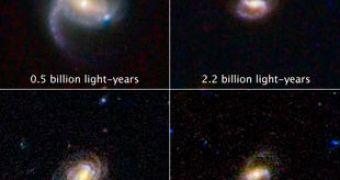Barred galaxies, having two arms trailing each other on either side of the galactic center, might have evolved in this particular shape with the passing of time, say astronomers who discovered that, compared to the first half of the universe's past, currently there are three times more galaxies that have bars. Models indicate that the bar takes shape as stars inside the disk orbiting the center of the galaxy can no longer maintain a circular orbit and fall into more elongated ones.
"The formation of a bar may be the final important act in the evolution of a spiral galaxy. Galaxies are thought to build themselves up through mergers with other galaxies. After settling down, the only other dramatic way for galaxies to evolve is through the action of bars," said Kartik Sheth of NASA's Spitzer Science Center at Caltech, lead author of the study.
Observations carried out with NASA's Hubble Space Telescope, involving more than 2,000 spiral galaxies, show that some 7 billion years ago spiral galaxies looked much more different than today, only one-fifth of them possessing a barred shape, as opposed to the two-thirds observed currently.
"They are forming mostly in the small, low-mass galaxies. We know that evolution is generally faster for more massive galaxies - they form their stars early and fast and then fade into red disks. Low-mass galaxies were also known to form more slowly, but now we see that they also made their bars slower," Sheth said while revealing that in the case of massive galaxies the ratio between barred and non-barred ones has remained roughly constant.
Sheth believes that the formation of the bar shape in galaxies is one of the most important factors in their evolution, as they are able to push high amounts of matter towards the crowded central area, forming bulges, feeding the supermassive black holes and most importantly, helping in the formation of new stars.
"They pull stars and gas out of their normal circular orbits into the central regions, perhaps even funneling gas to the central supermassive black hole. Without this fueling, the black holes would be starved and the central regions of galaxies devoid of young stars," said Nicholas Scoville of Caltech and principal investigator for Hubble's Cosmic Evolution Survey.
Our own Milky Way could have formed its bar much earlier in the history of the universe, being a relatively massive galaxy. "Understanding how this occurred in the most distant galaxies will eventually shed light on how it occurred here, in our own backyard," Sheth explained.

 14 DAY TRIAL //
14 DAY TRIAL //